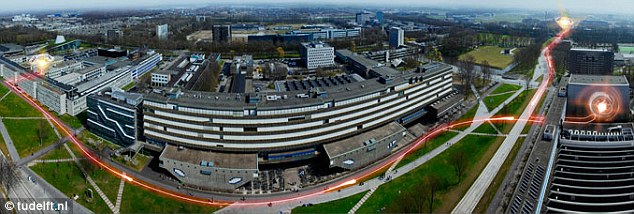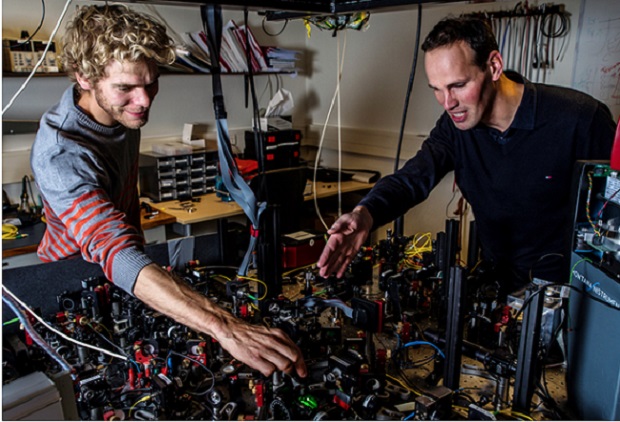Now, a groundbreaking experiment has provided the clearest proof yet that this quantum effect - which Albert Einstein famously dismissed as 'spooky action at a distance' - is in fact real. Quantum entanglement describes how the state of one sub-atomic particle can instantly influence the state of the other, no matter how far apart they are. This offended Einstein, since passing information between two points in space faster than the speed of light is supposed to be impossible.
In 1964, the scientist John Stewart Bell devised an experiment designed to rule out hidden variables that could offer a non-weird explanation for 'action at a distance'. But all the 'Bell tests' performed still contained 'loopholes' that, according to critics, could invalidate proof of entanglement. Now, writing in the journal Nature, scientists say two of the most important loopholes have been closed by a new version of the test.
The Dutch team entangled electrons held in tiny diamond traps 0.8 miles (1.3km) apart on opposite sides of the campus at Delft University. They did this in such a way that there was no chance of them 'secretly' communicating. Nor was there any possibility of a subset of paired particles being detected that was not representative of all those present.
Electrons have a magnetic property known as 'spin' that can be pointing either up or down. Until they are observed, there is no way of telling which of the two states they possess. In fact, due to quantum weirdness they are in a 'superposition' of both at the same time. Reality only kicks in when an observation is made, in much the same way that a flicked and spinning coin only shows a head or tails face when caught.

Other particle properties can be entangled the same way. The Bell test does a measurement on two sides of an entangled pair choosing randomly between possible 'questions' at both sides. Depending on which question is asked, a different property is measured.
The new test used pairs of single electrons, to make sure that all the entangled pairs were measured, allowing the team to close the detection loophole. In addition, the 0.8 miles (1.3km) distance between detectors was too far to allow light to travel between them in the time it took to ask a question and get an answer. This closed the locality loophole.
'It's exciting because, despite the reluctant acceptance by scientists that quantum physics really does seem to produce what Einstein called 'spooky action at a distant', said nanotech expert Professor John Morton, from University College London, said.
It remains profoundly unintuitive and throws up challenging philosophical questions.
'Previous demonstrations of the Bell test have had significant 'loop-holes', which can be used to explain away the results without having to accept the existence of this 'spooky action', while this new demonstration by Hanson and co-workers closes the most significant loop-holes present in previous tests. Second, performing this experiment required overcoming major practical challenges, and its success represents a milestone in mankind's ability to control light and matter at the deepest level and over long distances. This is a brilliant demonstration of how different quantum phenomena are from classical experience, underpinning the expectation that quantum technology will open up unprecedented capabilities to improve the future,' said Professor Kai Bongs, from Birmingham University.
The experiment has a potentially practical application, showing that quantum entanglement can be used as an encryption technique to allow super-secure communication.




"It remains profoundly unintuitive and throws up challenging philosophical questions."
Well then, the problem seems to be with incorrect intuition, which is based on incorrect paradigms. A so-called "mystical" view of the phenomenon of non-locality would not be surprised by the spooky action. In my view, which is supported by many years and countless hours of meditative and introspective practice, non-locality is quite obvious, and in rare moments it can be actually seen/felt/known. In that sense, non-locality is noumenal (context), and perceived locality is phenomenal (content).